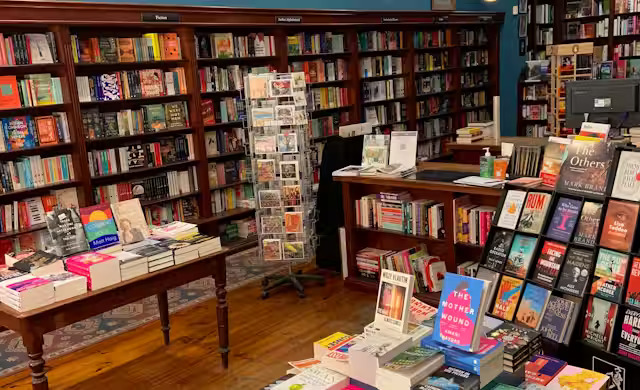Katya Johanson, Edith Cowan University and Bronwyn Reddan, Deakin University
At its height, Australia’s largest online bookseller, Booktopia, had a A$2.4 million turnover, 5 million customers, and sold a book “every 3.9 seconds”. Earlier this July it entered voluntary administration, a month after announcing the axing of 50 jobs and resignation of senior staff, including its chief executive. Shares had fallen to 4.5 cents, compared with about $3 a share in 2021.
But even at its peak, in the 2022 financial year, Booktopia was still unprofitable. What happened?
Co-founder of Booktopia, Tony Nash, who has said “I was never much of a reader”, defied the book industry’s expectations of a bookseller. Australian bookselling is a business of small profit margins, where workers are driven by their love of books.
But Nash simply identified the book trade as a business opportunity in the early days of online selling. When he attended a booksellers’ conference early in the Booktopia venture, Nash reviewed his local competitors as made up of people who lack business acumen: “These guys have no idea”.
Yet shortly after its 20th birthday, Booktopia has gone into receivership. By contrast, the independents and local chain stores have certainly shrunk in number, but are holding up reasonably well.
How is it that a data-driven, market-focused business has failed, while traditional book businesses continue to define the industry?
“It’s not that bookshops aren’t viable businesses,” Robbie Egan, chief executive of Australian booksellers association BookPeople told the Sydney Morning Herald last month, “it’s that Booktopia appears not to be.”
The rise and fall of Booktopia
Booktopia’s story is a shoestring-to-skyscraper one. A software developer by training, Nash was part owner, with his brother Simon and brother-in-law Steve Traurig, of a family business that capitalised on its founders’ early knowledge of the internet and Google search practices. He initially ran Booktopia as an out-of-hours pursuit, with $10 per day to invest from the family business.
Founded in 2004, the company grew quickly, from turning over $2,000 in the first month, to $30,000 in the fourth. It moved into a larger warehouse in 2014 and by 2018, it was shipping 30,000 parcels per day.
The COVID-19 pandemic lockdown orders gave people more free time at home, and were favourable to online trading. By 2020, Booktopia was listed on the ASX.
Booktopia’s fate is the latest instalment in a history of large-scale booksellers failing. In the 2010s, the global “megastore” Borders failed in Australia. Contrary to initial fears it would drive Australian-owned stores out of business, it proved shortlived.
These megastores were sandwiched between two kinds of competition: online booksellers like Booktopia, and the local handselling of independent bookstores.
Unlike a physical bookstore, where space constraints necessitate keeping a handful of copies of a limited range of “frontlist” (recently published) titles, Booktopia lists millions of titles on its websites, and holds around 150,000 in stock.
Booktopia touted its predictive sales algorithm as a competitive advantage that allowed the business to manage stock levels and allocate advertising spend by monitoring and forecasting product demand in real time.
Nash described it as a computer company that just happened to sell books. In contrast, physical bookstores tend to rely on publishers’ sales representatives and their own assessment of their local customer base to make stock choices.
Why is Booktopia collapsing?
The main competition for Booktopia is not physical bookstores, but international online booksellers. US-based Amazon has captured more of the Australian book market in recent years. Much of Booktopia’s early rise happened before Amazon started trading in Australia.
Low-cost, operating at an international scale and highly competitive, Amazon and, before it, Book Depository forced Booktopia to match their discounts. In particular, Book Depository was able to drive down prices because it provided free shipping due to a partnership with the UK Royal Mail, until it ceased operating in 2023.
Booktopia’s earlier growth led it to over-invest in its warehouse capacity. In 2023 it doubled its warehouse space and introduced automated packing. In concert with inflation-related increases in running costs on rent and electricity, and a post-COVID slump in book sales, this investment has further eroded its margin.
Perhaps Booktopia’s greatest mistake, though, was to undermine the confidence and trust of its customers. It has been the target of allegations of misleading advertising, with titles promoted as “in stock” taking several weeks to be delivered, and occasionally arriving damaged. The CEO blamed bottlenecking of stock around peak periods.
Adding insult to injury was Booktopia’s decision to give customers only a two-day period to seek a refund or replacement where their orders were damaged or faulty. Deeming this was not a “reasonable time”, the Federal Court last year ordered it to pay $6 million in penalties. But the damage done to consumer confidence has driven business to its competitors.
For those concerned with the health of the local publishing industry, Booktopia’s demise is no cause for celebration. “They serve a really important role in supporting Australian authors,” Egan told the Sydney Morning Herald last month.
Unlike Amazon, Booktopia has had a commitment to the local publishing industry. It has chosen to purchase from Australian publishers over their international counterparts where possible, and to support Australian authors.
Its ability to offer millions of titles for purchase also allowed consumers to see and access backlist titles, increasing the length of sales potential of a publication.
While Booktopia’s demise might shift slightly more market share to other local bookstores, it is more likely to benefit Amazon, who has no commitment to the local industry.
Katya Johanson, Professor of Publishing and Audience Studies, Edith Cowan University and Bronwyn Reddan, Research Fellow, Pathways to Teenage Reading, Deakin University
This article is republished from The Conversation under a Creative Commons license. Read the original article.


